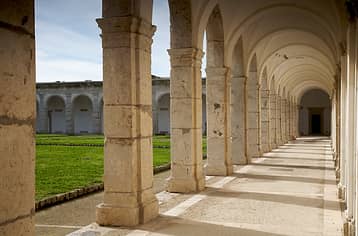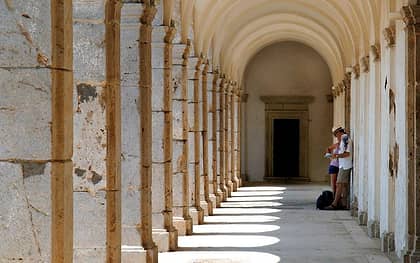Charterhouse of St. Giacomo





Charterhouse of San Giacomo
The Charterhouse of San Giacomo is the oldest historic building on the island of Capri, built in 1371. Today it has been transformed into a cultural hub. If you’re looking for shade and silence during your walk through Capri’s sunlit lanes, this is the perfect place.
What you can visit:
The Small Cloister and the Great Cloister
Archaeological Museum (Roman artifacts, Blue Grotto statues)
Diefenbach Museum (German symbolist art)
A quiet, uncrowded spot just a few steps from the Piazzetta
Opening hours | |
|---|---|
January, February, March | 10:00 - 14:00 |
April, October, November, December | 10:00 - 16:00 |
May, June, July, August, September | 10:00 - 18:00 |
Closed on Mondays
Tickets
Full price: €10. Reduced (18–25 years): €2. Free for under 18. Tickets can be purchased online at www.museiitaliani.it or at the entrance, card payment only. Times and prices may vary—check at the info points in Marina Grande or the Piazzetta.
How to get there
On foot from the Piazzetta (about 10 minutes).
Reviews at a glance
Visitors describe the Charterhouse as a peaceful oasis in the heart of Capri. They enjoy the quiet cloisters, views of the Faraglioni, the Diefenbach Museum and temporary exhibitions. Some mention neglected gardens, empty rooms and unclear opening times, but overall the Charterhouse remains an authentic, uncrowded stop.
The history of the Charterhouse
The history of the Charterhouse
Over the centuries, the Charterhouse underwent many transformations: plundered by Turkish pirates in the 16th century, renovated and expanded in the 17th, it later became a barracks and prison under Napoleon. In the 20th century, it hosted cultural events, Futurist exhibitions, and even American troops during the war.
Today, visitors can still read this layered history: from the “upper house” devoted to monastic silence and prayer, to the “lower house” where kitchens, cellars, and workshops tell of everyday life.
The entrance to the Charterhouse lies at the end of an avenue, next to a fortified tower. The Charterhouse is comprised of three blocks of buildings: one which is separate from the convent and houses the pharmacy and women's church; one for the converse monks and for the external guests with annexed granaries, stables and the monks workshops; the last block was reserved for the life of seclusion with a series of cells around Choistro Grande cloister and the other rooms encircling the smaller Chiostro Piccolo.
The Chiostro Grande follows a late renaissance plan with cross vaults on stone columns, the area at the center is organised following a geometrical design with green spaces. The Chiostro Piccolo has delicate cross vaults on Roman marble columns.
Today, the Charterhouse is seat of the Archeological Museum, the Diefenbach Museum and, during the summer, functions as venue for concerts and cultural events.
Archaeological Museum of Capri
Archaeological Museum of Capri
The Archaeological Museum of Capri, housed in the Charterhouse of San Giacomo, is a treasure trove of artifacts that tell the ancient history of the island. Inauguratedon July 2024, with the exhibition "The Island of the Caesars: Capri from Augustus to Tiberius," the museum displays 120 artifacts including marble sculptures, frescoes, and pottery, originally held at the National Archaeological Museum of Naples and now back on the island. These artifacts illustrate Capri's rich cultural heritage and its role during the Roman era, offering visitors a captivating journey through time.
The museum highlights the ongoing dialogue between Capri’s treasures and the surrounding sea. Multimedia installations make the visit accessible and immersive, showcasing not only statues and frescoes but also exquisite silverware and ceramics. The experience culminates with the evocative display of the Blue Grotto sculptures, enhanced by light effects and an elegant soundscape.
Diefenbach Museum
Diefenbach Museum
The Diefenbach Museum, also located in the Charterhouse of San Giacomo, is dedicated to German painter Karl Wilhelm Diefenbach, a symbolist who lived in Capri in the early 20th century.
Diefenbach was an unconventional figure: a reformist and pacifist who embraced the principles of Lebensreform, wearing a white tunic and preaching universal love and a return to nature. In his canvases, Capri emerges as majestic and timeless, captured through iconic viewpoints such as Marina Piccola, the Natural Arch, and Monte Solaro.
The museum's collection includes a wide range of works reflecting the artist's mystical and spiritual vision, inspired by the natural beauty of the island. Diefenbach's works, characterized by strong symbolism, offer a unique opportunity to explore the interaction between art and nature.
Useful tips
Visit early in the morning to enjoy the peace.
Don’t expect furnished interiors: focus is on architecture and museums.
Bring water, especially in summer—few refreshment spots nearby.
Double-check opening hours at local info points, not only online.
Combine with a walk to the Gardens of Augustus for views.
Allow at least half an hour: the visit is short but best enjoyed slowly.
Look out for temporary exhibitions or concerts.
Use the audio guide to get the most out of the history.
Perfect for shade and quiet on hot days or for a rainy day


FAQ - Frequently asked questions
How long does it take to visit the Charterhouse of San Giacomo?
On average, the visit takes 30–45 minutes, depending on whether you focus only on the cloisters or also explore the museums. Some visitors take a quick walk, while others stay longer for exhibitions or events. To fully enjoy the architecture and the collections of the Archaeological and Diefenbach Museums, allow about one hour.
Is it worth visiting if you’re short on time?
Yes, as the visit is short but meaningful. Even with just 30 minutes you can see the cloisters and take a look at the museums. What’s more, the Charterhouse is right next to the Gardens of Augustus, another must-see in Capri, so you can easily combine the two.